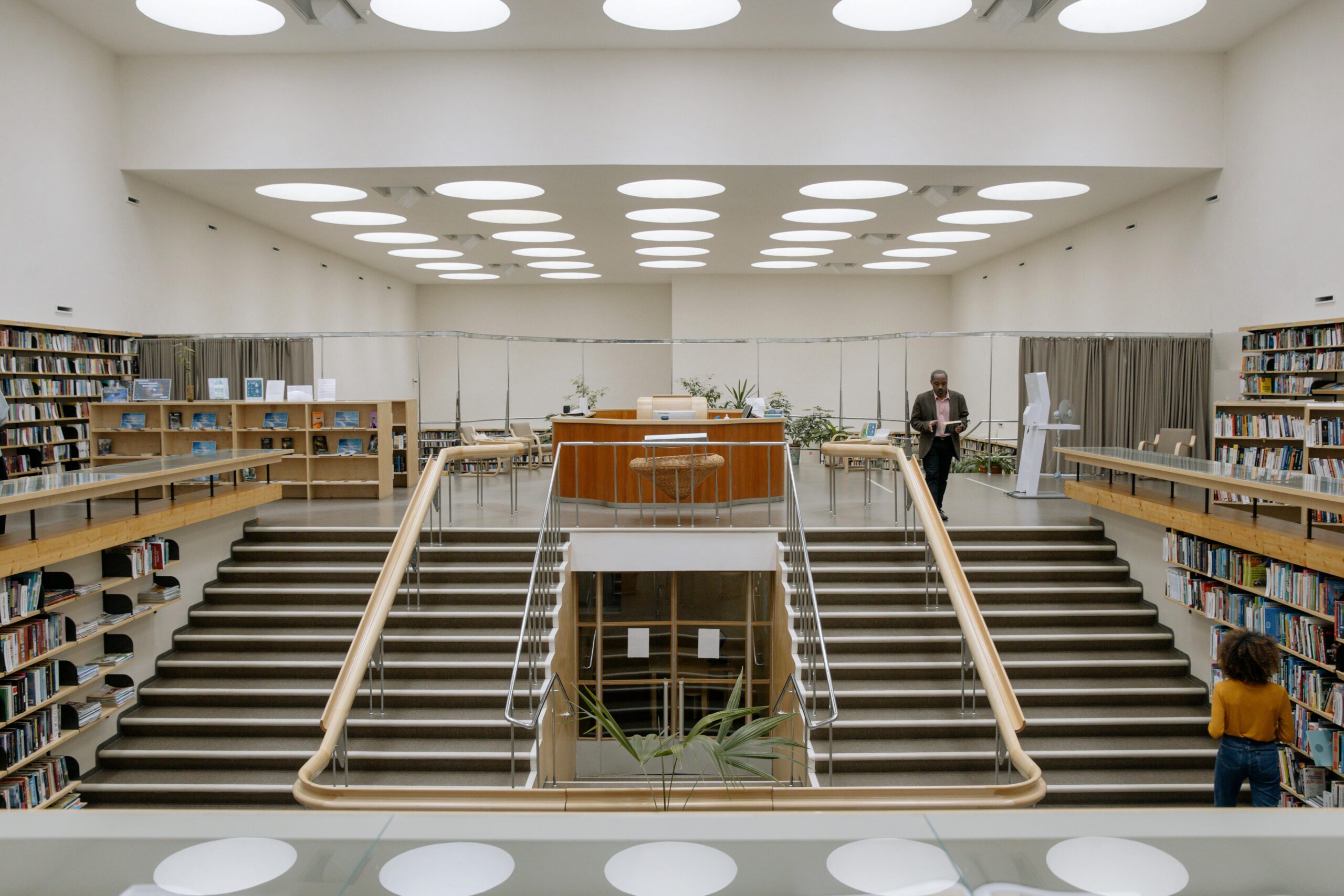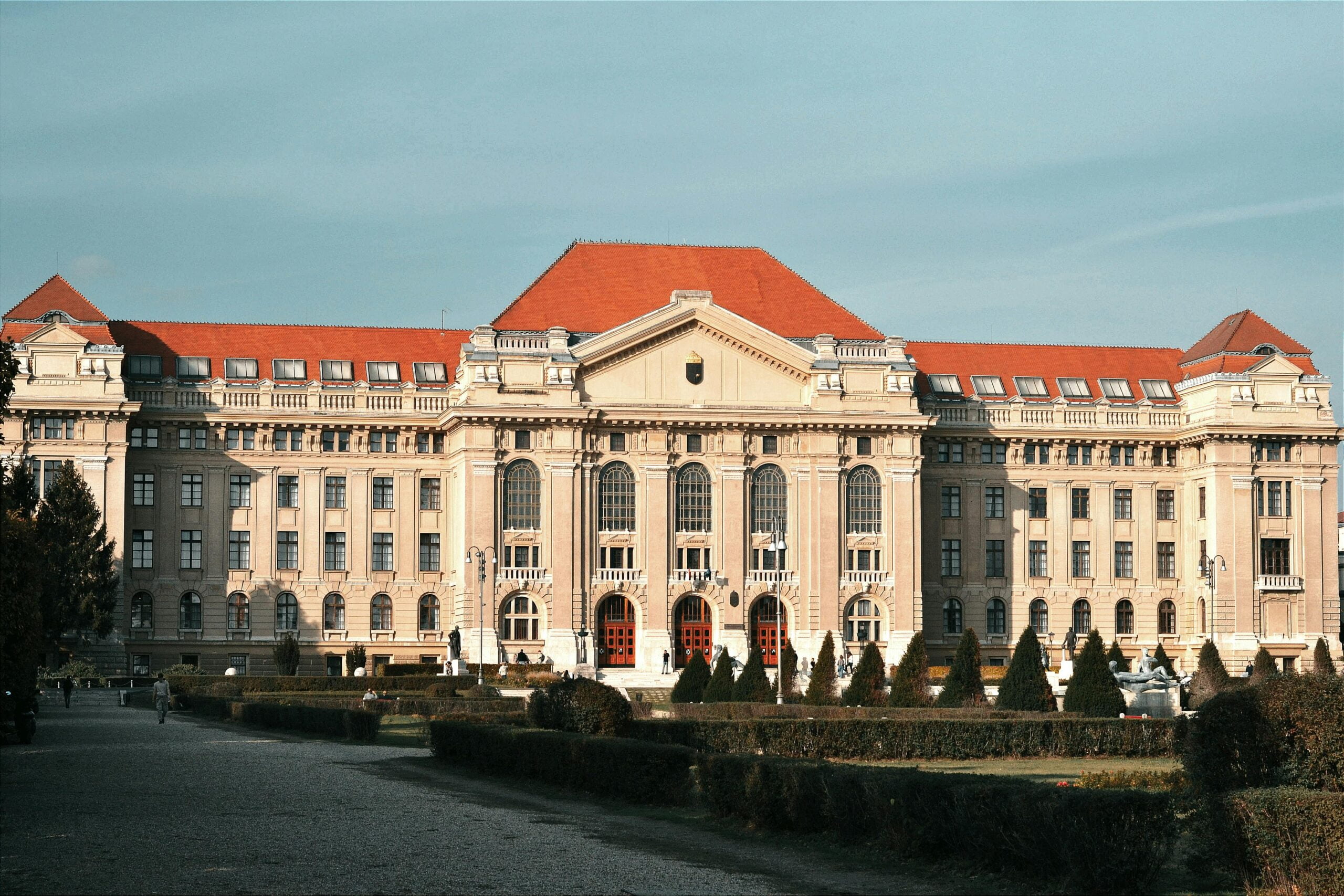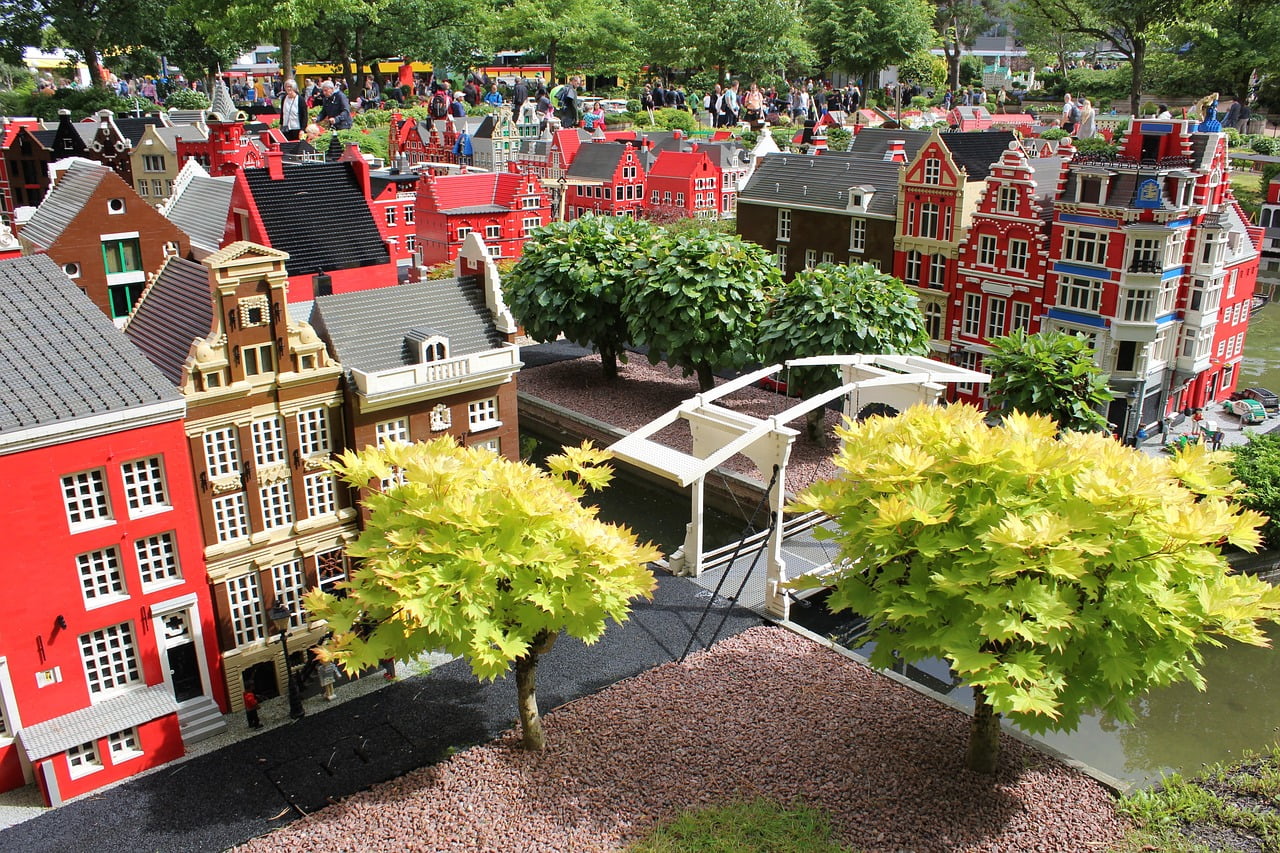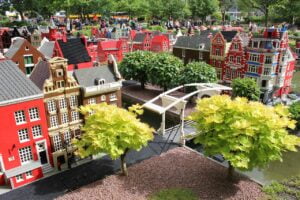What is Staircase and Why it is used?
A staircase, also known as stairs, stairwell, or stair room, is a room in any type of building where a staircase is located. It is used for vertical connectivity between different levels or floors of the building. It provides vertical movement for users from one floor to another. A staircase consists of two flights, one for going up and the other for going down. It moves between different levels of the building and is collectively known as a staircase. Stairs have a series of steps that contain risers and steps, which allow us to walk on them and move on different levels. It is not just used for vertical movement, it is also beneficial in emergencies, natural disasters, acts of terrorism, and others.
This article will cover the design, standards, types, and other important information about staircase.
Vaastu Standards related to staircase
Things to follow
- As per the standards or guidelines of Vaastu, the suitable direction for the construction of the staircase is in the south, south-west, west, or north-west direction of your house.
- A staircase should not be designed in an anti-clockwise pattern, as it brings negativity into your house. It should be designed in a clockwise pattern for positivity and other benefits.
- While coming down from the stairs, one must face in the east or north directions.
- Similarly, while going up, one must always face in the south or west directions.
- The colors should be decided based on the direction of the staircase.
- The number of steps on the stairs of the house should always be an odd number, and the number should not end with zero. [1]
Things to Avoid
- The staircase should never be constructed in a north-east direction.
- Constructed of stairs in the center of the house, it is considered the most dreadful Vastu Dosh.
- You should never design a Pooja room or area, a toilet, or a cash room under the stairs.
- Do not opt for circular, spiral, or round-shaped stairs. It is believed that it causes bad health, as per Vaastu.
- The stairs should not touch the northern or eastern walls of the house.
- The stairs should not start from the Pooja room (NE), kitchen (SE), or cash room (N). [1]
Components of Staircase
- Tread: Also referred to as going. It is the horizontal surface of the stairs between two risers where we rest our feet. The tread should be designed as per the dimensions of our foot so that someone can easily walk over it.
- Riser: Also referred to as rise. It is a vertical surface just after every tread.
- Nosing: It is protecting part of the tread just beyond the face of the riser. A nose can be designed in various shapes, like semicircular, bullnose, flat, and others.
- Pitch line or slope: It is the angle that the line of the stair makes with the horizontal
- Stringer or strings: These are the sloping members that are provided at the edges of the steps, which support them with the stair. It binds all the steps together to form a stair.
- Landing: It is a platform at the top and bottom level of the stair from where a turning is provided in a stair (except straight flight stair).
- Flight: This is a continuous series of steps between two landings.
- Handrail: It is the top member of a railing on which people rest their hands and take support.
- Newel Post: It is a vertical member slightly thicker than a handrail placed at the beginning and end of the flights to connect the ends of the strings and handrail.
- Baluster: It is a vertical member, either made of wood or steel, used to support the handrail.
- Railing: Collectively, all three elements above form a railing, which creates barriers along the edges of the stairs to prevent accidents.
- Headroom: It is a clear vertical distance between the tread and the ceiling or above the structure.
Other important components
- Scotia: It is a type of molding just provided beneath the nosing to provide more strength to the nosing.
- Waist Slab: Mainly constructed with RCC, it is a slanting member that is constructed to land on the stairs on which brick steps are constructed.
- Soffit: It is under the side of the stairs.

Types of Staircase
There are three major types of Staircase, which are discussed below. Some other important types from them are also discussed:-
Straight Staircase
Straight Flight Stair
- It is a type of staircase that is designed where there is a lack of space, and going narrow and long is the only option. This type of staircase is designed in two ways: one without the landing and one with a series of steps only. And one with the landing, which is a good practice as it gives users some time to rest and take a break while walking on it.
- This type of staircase runs in only one direction and doesn’t have any turns in it.
- This type of staircase is commonly used in small residential projects. For commercial, institutional, and educational projects, it is not recommended as the footfall in these types of buildings is higher and this type of staircase is not feasible for the users.
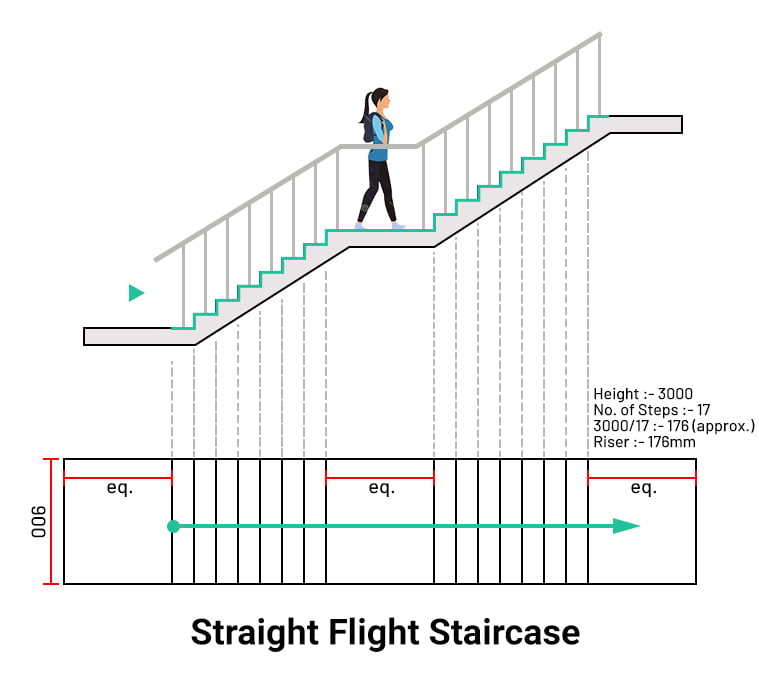
Refer to the information attached below for staircase standards as per NBC.
Turning Staircase
Quarter Turn Staircase
- Quarter-turn stairs are also known as L-shaped staircases. This type of staircase consists of two flights and a 90° turn between the flights.
- This type of staircase runs in two different directions.
- Suitable to use in any type of building.
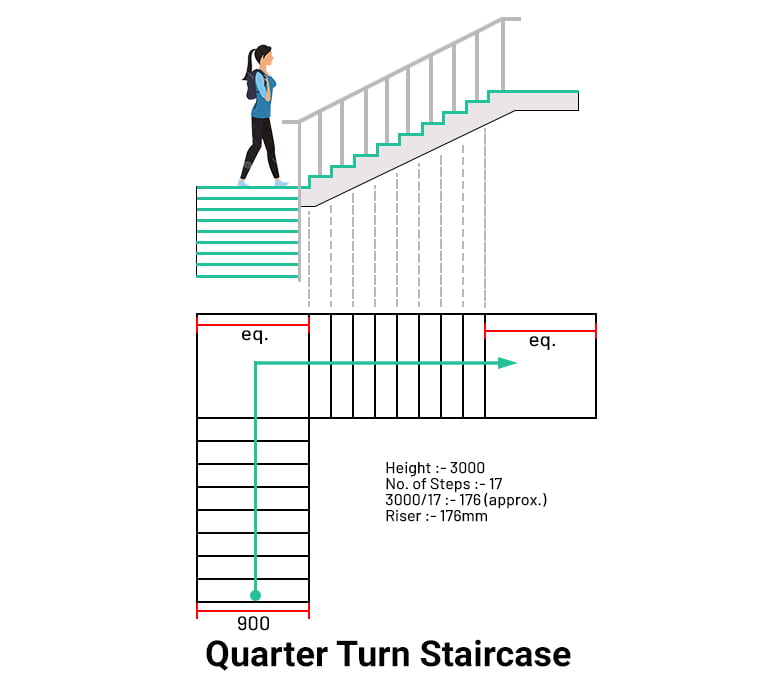
Half Turn Staircase
Dog Legged Staircase
- One of the most suitable types of staircases is widely used these days because of the comforts it provides. This type of staircase consists of two straight flights and a 180° turn between those two flights. That is known as a landing.
- This type of staircase runs in two different directions.
- If the space for the stairs is limited, then additional steps on landings can be designed. The steps designed on the landings are referred to as winders.
- This type of staircase can be used in any type of building. As it is feasible for catching heavy footfalls.
- Dog-legged staircases are also used as fire staircases, as they are the most convenient type of staircase.
- It is referred to as dog-legged because this staircase appears like dog legs when seen from sectional level.
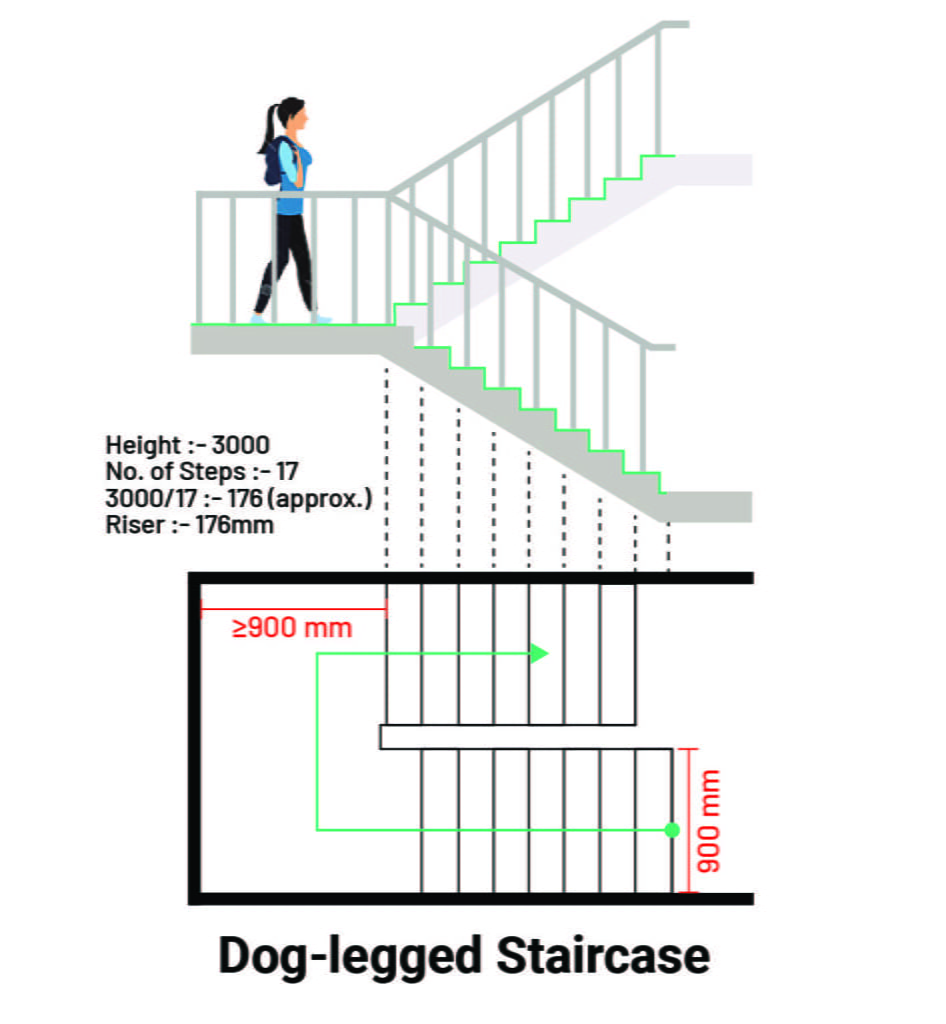
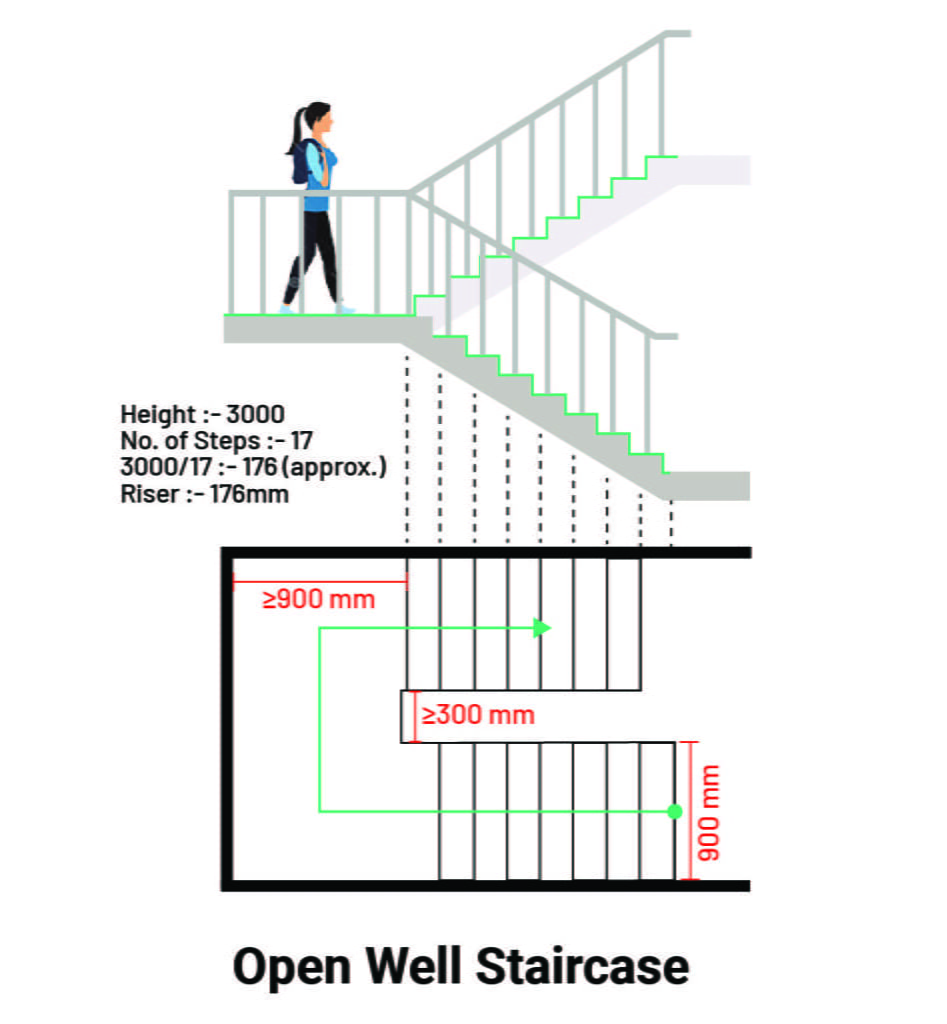
Open well Staircase
- This type of staircase is slightly similar to the dog-legged staircase. Just the gap between two adjacent flights has been increased from a minimum of 300 mm (12 inches) to a maximum as per your design requirements.
- This type of staircase runs in three different directions.
- As a dog-legged stair, the landing of the open well stair is also used to design steps. It can be normal steps or winders.
- The shape of the open-well staircase from above looks like C and U.
- Open-well stairs are widely used in residential buildings as they provide a duplex kind of space inside the house. Has mastery of connecting two different levels of stairs through visibility and approach on different levels at a time.
- This type of staircase is mostly used in residential projects, but it can also be used in other types of buildings.
Three Quarter turn staircase
- This type of staircase is similar to the open-well staircase, but the number of turns is increased here.
- It has a total of three flights and 270° turns between them, and the shape of the stair looks like the letter O.
- It is suitable for residential projects, but avoid using it in other buildings as the number of turns on this type of staircase is not feasible for every user.


Bifurcated Staircase
- This type of staircase has three different flights and has one common landing between them, which turns 180° in two different directions.
- This type of staircase runs in three different directions.
- Bifurcated stairs are used at the entrance and in luxury apartments.
- One of the best stairs is used to divert user movement in two different directions.
Refer to the information attached below for staircase standards as per NBC.
Continuous Staircase
These types of staircases are round or curved in shape. They are designed where we have very limited space available for stairs to be built. Aesthetically, they look amazing and enhance the beauty of the space. They can be used in residential and commercial buildings. These types of stairs are commonly used for emergency exits, except helical stairs.
Circular Staircase
- A circular staircase covers all the circumference of the circle and makes a perfect circle. It usually turns more than 90°.
- This type of staircase has a big hole at the center, and a person can look down or up through it.
- The center space of the stair is the perfect location for the installation of chandeliers; it will give a luxurious feel to the stair. [2]
Spiral Staircase
This type of staircase consists of a central pole around which a series of steps are arranged in a spiral shape.
Helical Staircase
It is more of a semi-circular staircase that does not have any poles at the center and typically has an inner and outer radius. On which a handrail is installed to provide safety. An image is attached below to explain it. [2]

Refer to the information attached below for staircase standards as per NBC.
There are also some other types of staircases that are used in modern-day construction, like prefabricated stairs, floating stairs, hanging stairs, parametric stairs, folded plate stairs, cantilever stairs, space-saving staircases, and others. We will come across new designs or types in the future with the development of engineering, software, and architecture.
NBC Standards for Fire Staircase
- In non-naturally ventilated areas, fire doors with a 120-minute fire resistance rating are required. These doors should be placed specifically at the entrance to lift lobbies and stairwells to prevent the potential upward spread of fire and smoke caused by a funnel or flue effect.
- Overhead or sliding doors shall not be installed.
- Doors in exits shall open in the direction of exit. In case of assembly buildings (Group D) and institutional buildings (Group C-1), exit door shall not open immediately upon a flight of stair and all such entries to the stair shall be through a landing, so that such doors do not impede movement of people descending from a higher floor when fully opened. While for other occupancies, such doors shall not reduce the pathway in the landing by more than half the width of such staircase.
- At least half of the required exit stairs from upper floors (rounded to the next higher number) shall discharge directly to the exterior or through exit passageways.
- Unless otherwise specified, all the exits and exit passage ways to exit discharge shall have a clear ceiling height of at least 2400 mm (8 ft.). However, the height of exit door shall be at least 2000 mm (80 inches).
- The minimum width of a tread without nosing must be 250 mm (10 inches) for staircases in residential buildings. For assembly, hotels, educational, institutional, business, and other buildings, this width should be a minimum of 300 mm (12 inches). Treads must be constructed and maintained to prevent slipping. Additionally, the maximum height of a riser is 190 mm (7.6 inches) for residential building staircases and 150 mm (6 inches) for other buildings. The number of risers per flight should not exceed 12.
Internal Staircase
- A handrail shall be provided on one side of the staircase of a width less than 1500 mm (60 inches), and on both sides of the staircase of a width of 1500 mm (60 inches) or more. The projection of the handrails in the staircase width shall not be more than 115 mm (4.6 inches).
- No electrical shafts, air conditioning ducts, gas pipes, etc. shall pass through or open in the staircases.
- Lifts shall not open in staircases.
- No combustible material shall be used for decoration or wall paneling in the staircase.
- Stair cover (Mumty) should not exceed 3000 mm (10 feet.) in height.
- The minimum headroom required in a passage beneath the landing of a staircase and beneath the staircase itself is 2200 mm (7 feet 4 inches). (See Fig. Below)
| S. No. | Occupancy Group | Maximum Travel Distance (m) | |
| Type 1 and 2 | Type 3 and 4 | ||
| 1. | Residential (Group A) | 30 | 22.50 |
| 2. | Educational (Group B) | 30 | 22.50 |
| 3. | Institutional (Group C) | 30 | 22.50 |
| 4. | Assembly (Group D) | 30 | 30 |
| 5. | Business (Ground E) | 30 | 30 |
| 6. | Mercantile (Group F) | 30 | 30 |
| 7. | Industrial (Group G) | ||
| G-1, G-2, | 45 | See Note (From here to below) | |
| G-3 | 22.50 | ||
| 8. | Storage (Group H) | 30 | |
| 9. | Hazardous (Group J) | 22.50 |
Source: NBC
Note:
- For a fully sprinklered building, the travel distance may be increased by 50% of the values specified.
- Ramp shall not be counted as an exit in the case of basements below the first basement in car parking.
- Construction of type 3 or type 4 is not permitted.
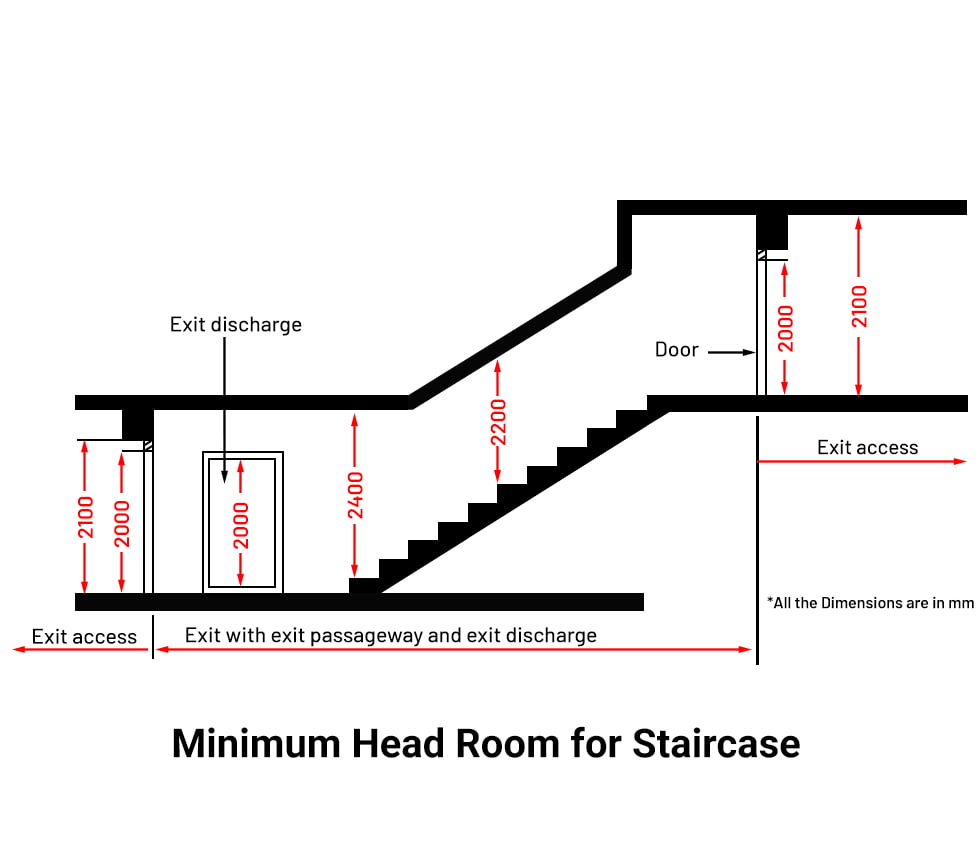
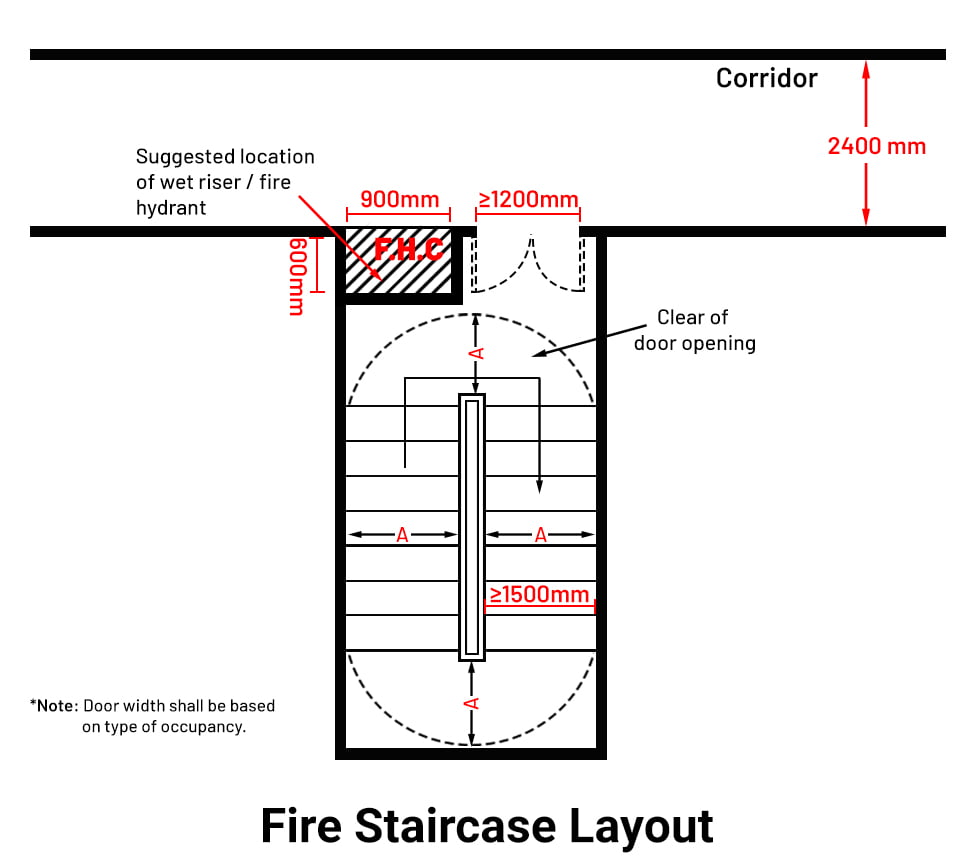
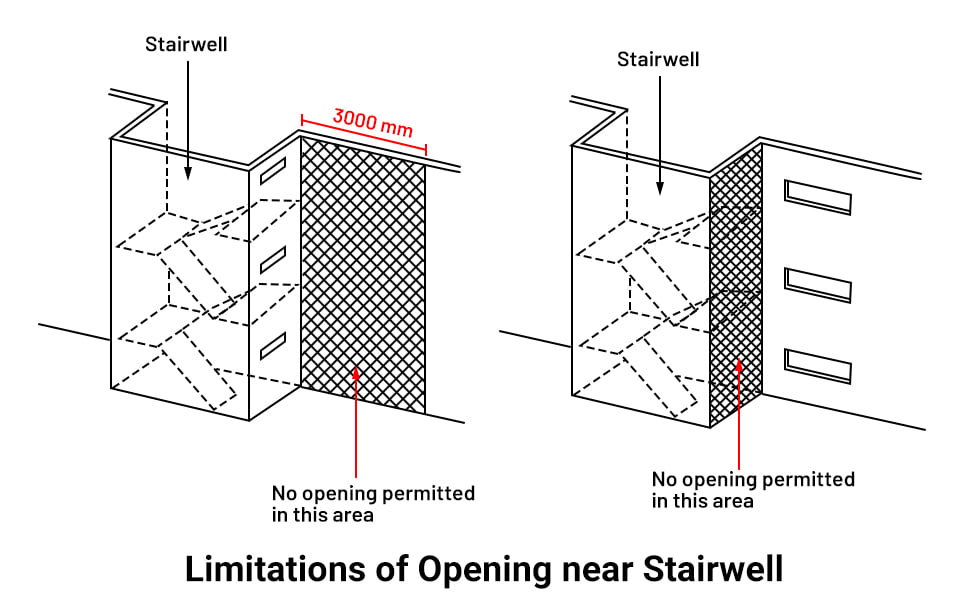
External staircases
- All external stairs must have a direct connection to the ground.
- The entrance to external stairs should be separate from and located away from the entrance to internal staircases.
- Care shall be taken to ensure that no external wall or window opening opens on to or close to an external stair. If such openings exist within 3000 mm (10 ft.) from an external staircase, they shall be protected with fire-rated doors or window assemblies with a rating of at least 60 min. (See Fig. above)
- External staircases must not have an inclination angle greater than 45° from the horizontal.
- Handrails, to be provided on both sides, shall be of a height not less than 1000 mm (40 inches) and not exceeding 1200 mm (48 inches). There shall be provisions for balusters with a maximum gap of 150 mm (6 inches).
| S. No. | Type of Buildings | Width of flight |
| 1. | Residential (A-2) *Note: For row housing with 2 storeys, the minimum width shall be 750 mm | 1000 mm |
| 2. | Residential (A-1, A-3, A-4) | 1250 mm |
| 3. | Residential Hotel (A-5 & A-6) | 1500 mm |
| 4. | Assembly *Note: The width of stairs may be accepted to be 1500 mm in case of assembly occupancy having less than 150 persons. | 2000 mm |
| 5. | Educational | 1500 mm |
| 6. | Institutional | 2000 mm |
| 7. | All other occupancies | 1500 mm |
UK Standards for staircase
External Staircase Standards
- A rise of between 150 mm (6 inches) and 170 mm (6.8 inches) and with a going of between 280 mm (11.2 inches) and 450 mm (18 inches) (reduced to between 75 mm (3 inches) and 150 mm (6 inches) rise, a minimum going of 280 mm (11.2 inches) in domestic situations). There should be no open risers.
- Access stair width should be no less than 1200 mm (48 inches) wide (reduced to 900 mm (36 inches) for domestic situations).
- Access stairs should have landings provided, not less than 1200 mm (48 inches) wide. For every 12 risers for a going of less than 350 mm (14 inches) or 18 risers if the going is more than 350 mm (14 inches) (total of 1800 mm (6 ft.) rise in domestic situations). There should be at least a 1200 mm (48 inches) level approach at the foot and head of the stair, with intermediate landings also of 1200 mm (48 inches) (reduced to 900 mm (36 inches) for domestic situations).
- Handrails should be provided on both sides. In the case of stair access that is wider than the minimum, additional handrails are required along the center line to ensure that the effective width of access is not less than 1000 mm (40 inches) or more than 1800 mm (6 ft.) wide.
- In the case of private stairs, the maximum pitch is 42°. (Source: Metric Handbook Planning and Design Data)
| S. No. | Spaces | Rise | Going | ||
| Minimum | Maximum | Minimum | Maximum | ||
| 1. | Private Stairs | 150 mm | 220 mm | 220 mm | 300 mm |
| 2. | Utility Stairs | 150 mm | 190 mm | 250 mm | 400 mm |
| 3. | General Access Stairs | 150 mm | 170 mm | 250 mm | 400 mm |
Source: Metric Handbook Planning and Design Data
Internal Staircase Standards
- Stairs should not be less than 1200 mm (48 inches) wide. (There is no minimum in domestic situations, but 850 mm (34 inches) is suggested, with 600 mm (24 inches) when the stair is serving only one room.)
- Treads should be consistent throughout the flight, with a rise and going as shown in the table above. There should be no open risers (except in domestic situations where they are constructed with a minimum 16 mm (0.6 inch) overhang and a 100 mm (4 inches) diameter sphere cannot pass through the risers).
- For tapered treads, the standard design principles should still be adhered to, but with the going measured at the middle of the stair, subject to a minimum 50 mm (2 inches) tread at the narrow end.
- Stairs should have landings provided not less than 1200 mm (48 inches) long, for every 16 risers in the case of a utility stair and for every 12 risers for general access stairs. There should be at least a 1200 mm (48 inches) level approach at the foot and head of the stair with intermediate landings also of 1200 mm (48 inches) (reduced to the stair width with 400 mm (80 inches) unobstructed by door openings for domestic situations).
- Handrails should be provided on both sides. In the case of general access stairs that are wider than the minimum, additional handrails are required to ensure that the effective width of access is not less than 1000 mm (40 inches) or more than 2000 mm (80 inches) wide.
- A minimum of 2000 mm (80 inches) of clear headroom should be provided at all landings and access points, as well as above the pitch line, measured at the outer limit of each going. (Source: Metric Handbook Planning and Design Data)
US Standards for Staircase
Building code standards for staircase vary from state to state and county to county in America. These are some of the general standards for staircase that need to be followed:
- The minimum width of the tread should be 9 inches (229 mm), excluding the nosing for private residences. The riser should be a minimum of 5 inches (127 mm).
- An optimal rise-to-tread ratio is typically considered to be around 17/29”, which is approximately 0.59. This ratio corresponds to a pitch angle of about 30°.
- The maximum nosing protrusion is typically limited to 1.25 inches (32 mm) to prevent individuals from tripping on the nosing.
- The height of the handrail from the nose of the tread should be between 34 and 38 inches (864 and 965 mm). From landing, it may be different, and typically it is taken at 36 inches (914 mm).
- The diameter of the handrail should be between 1.25 and 2.675 inches (31.8 and 67.9 mm), so that users can easily hold onto the handrail.
- The maximum space between a handrail and balusters should be 4 inches (102 mm).
- The minimum height of the headroom should be 83 inches (2110 mm). [Source: Time Saver Standards for Interior Design & Planning] [3]
I recommend you guys study Time Saver Standards for Interior Design to know in detail about the American Standards for Staircase Design.
Other Important Standards for Staircase
- A stair with more than three steps should have a handrail to prevent accidents.
- The minimum width of the staircase to allow people to pass easily should be 750 mm (30 inches) (a recommended 900 mm (36 inches) width if used to move furniture on it).
- For two people to pass easily, the width of the staircase should be 1250 mm (50 inches), and for three people, it should be a minimum of 1850 mm (74 inches).
- High-rise buildings up to 60 meters high: at least two emergency stairs must be available, which must be located opposite each other in two separate fire compartments. (Source: Neufert)
- The minimum width of the tread should be 250 mm (10 inches) for residential and 300 mm (12 inches) for commercial and institutional, excluding the nosing. The riser should be a minimum of 175 mm (7 inches) for residential and 150 mm (6 inches) for commercial and institutional.
- The minimum width of the stairs should be 850 mm (34 inches) for residential purposes {recommended: 900 or 1000 mm (36 inches or 40 inches)}. For commercial purposes, the width of the stairs should be 1500 mm (5 ft.), and for educational purposes, it should be 1800 mm (6 ft.).
- The height of the handrail from the nose of the tread should be between 1000 mm (40 inches).
- Stair covers (Mumty) should not exceed 3000 mm (10 ft.) in height. (Source: NBC)
- The recommended slope of stairs should be between 30° and 45°.
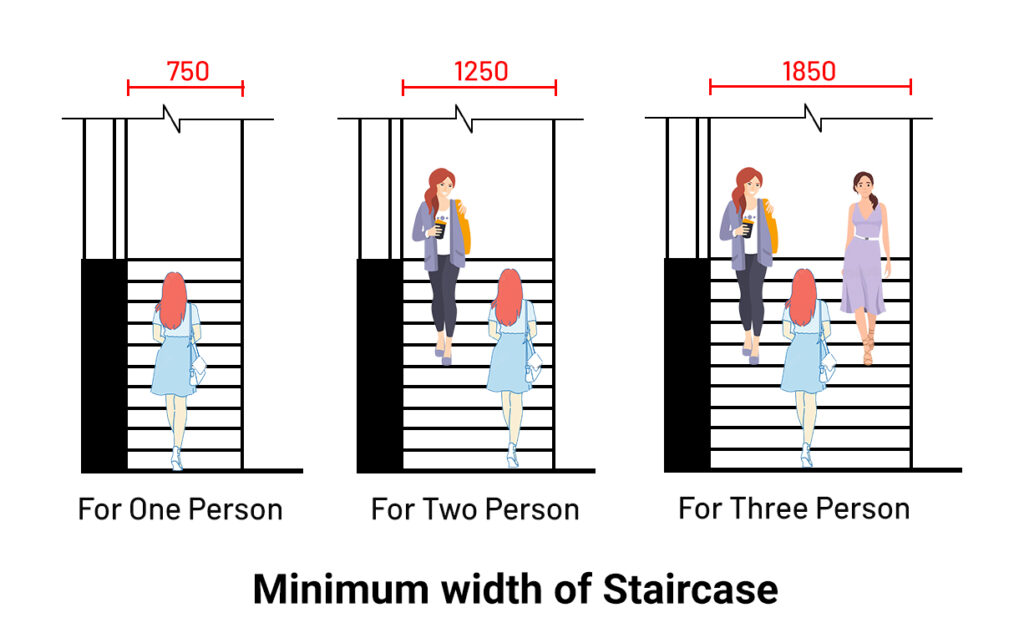
Design Consideration for Staircase
- The staircase in residential projects should be designed near the entrance.
- The stairs should be strategically located so that they are accessible from every space in the house.
- A staircase should not be planned in a congested space; it should have a spacious area.
- Select the suitable type of stair that easily fits your available space.
- The height and width of the riser and tread should be consistent throughout the flight. Having variations in dimensions can lead to several kinds of accidents.
- The width of the flight and landing should always be equal (the width of the landing can be increased as per your requirements).
- Stairs should have a good source of natural light and ventilation.
- A stair with a series of steps should have a landing after every 10 to 12 steps to make it comfortable for the user walking on it.
- For residential purposes, a 1000 mm (3 ft. 6 inches) wide staircase is suitable. For commercial, it should be 1500 mm (5 ft.), and for educational, it should be 1800 mm (6 ft.).
- A stair should not have a series of steps above 12 and below 3 to make it comfortable for the users.
- The slope or pitch of the stair should not be more than 45° or below 30°.
- A stair should be covered from above with a Mumty, and the height of the Mumty should be a minimum of 2400 mm (8 ft.).
- A staircase should continue from the ground floor to the top floor. Having two stairs in a house is not appropriate. (For the tenant house and penthouse, we can have two stairs.).
- At the beginning and end of the stairs, an area equal to the landing should be left.
Materials used for construction of Staircase
Staircases can be constructed using various materials, including:
- Wood: Traditional and versatile, offering warmth and natural beauty.
- Concrete: Known for its durability and versatility, often used in modern and industrial designs.
- Steel: Provides strength and allows for sleek, modern designs.
- Glass: Adds a contemporary and elegant touch, often used in modern and minimalist designs.
- Stone: Offers a luxurious and timeless appeal, commonly used in high-end residential and commercial projects.
- Brick: Durable and versatile, suitable for both indoor and outdoor staircases.
- Tile: Provides endless design possibilities, with options for various colors, patterns, and textures.
- Aluminum: Lightweight and corrosion-resistant, suitable for both indoor and outdoor applications.
- Bamboo: Eco-friendly and sustainable option, offering a unique and natural look to staircases.
A staircase can be designed with a combination of two or three materials. Designing stairs like that provides more strength and also makes them aesthetically appealing.
Examples of Famous Staircase Design
- Vessel, Hudson Yards, New York, USA
- Umschreibung, Munich, Germany
- Bramante Staircase, Vatican Museum, Vatican City
- Spiral Staircase, Loretto Chapel, Santa Fe, New Mexico
- Tulip Stairs, Queen’s House, London, England
*Note: The dimensions written in feet, inches, and mm are individual dimensions, not converted.

